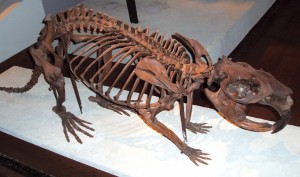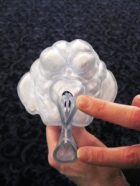The secret songs of giant beavers
Scientists discover a noisemaking chamber in the extinct animal’s skull

Giant beavers vanished from North America about 10,000 years ago. But they had a secret in their heads: a long compartment that stretched from front to back in the animals’ skull. Caroline Rinaldi is a paleontologist who studies extinct mammals. She may have figured out the chamber’s purpose. She recently presented her ideas to a meeting of scientists in Las Vegas, using a plastic copy of the skull’s hidden tunnel to demonstrate her surprising find.
She held the model to her lips and blew a note. It produced a noise that Science News reporter Susan Milius described as “bleating.” The sound wasn’t pretty. But it showed that the hidden cavity made noise. And that suggests that it might have even helped the animal communicate.
The hidden passage ran underneath the airway connecting the nose and throat. It had no opening to the outside of the skull. Where the two passageways touched, a long, skinny slit would have let air through. Sounds bouncing around inside the skull’s sinus cavities could have become louder.
In addition to bone, animals use soft tissues to vocalize. As a result, the sounds Rinaldi made at the meeting probably differed from any beaver cries last heard 10,000 years ago. “We don’t have the soft tissue,” she said. Soft tissue includes things like organs and membranes. And unlike bone, they are rarely preserved as fossils.

The titanic rodents probably weighed 100-plus pounds. Some scientists say these animals may have been as big as black bears. Their pointed, curved front teeth were as big around as quarters.
Despite coming from the same family, modern beavers won’t help scientists like Rinaldi solve mysteries about the giants. Their skulls are shaped differently.
Giant beavers flourished during the last Ice Age. It started about 70,000 years ago and ended around the time the giant beaver went extinct. Many beasts alive during the time period looked like oversized versions of modern animals, but their bodies didn’t necessarily work in the same ways.
“It’s a great lesson,” Larry Flynn told Science News. “If you take a modern animal and scale it up, you’d be wrong.” Flynn, who did not work on the new giant beaver study, studies ancient rodents at the Peabody Museum of Archaeology and Ethnology at Harvard University. He told Science News that the giant beaver looked puny when compared with some of the other large rodents alive at the time.
Rinaldi is a researcher at the University of Missouri-Kansas City School of Medicine. She used CT scans of a giant beaver’s skull to create her plaster model. CT stands for computerized tomography, and CT scans are X-ray images taken from many different sides of an object. Later, they can be assembled to create a 3-D image of that object. The hidden passage in the giant beaver’s head showed up on CT scans.
Rinaldi reported she’d never seen anything like it before. “I don’t know of any other animal that has this,” she said.
POWER WORDS (adapted from the New Oxford American Dictionary)
CT scan A three-dimensional image made from X-ray images of an object taken from different angles.
X-ray Radiation of high energy and very short wavelength (between ultraviolet light and gamma rays) that is able to pass through many materials that block light.
paleontology The branch of science concerned with fossil animals and plants.
rodent A gnawing mammal of an order that includes rats, mice, squirrels, hamsters, porcupines and their relatives, distinguished by strong, constantly growing incisors and no canine teeth. They are the largest order of mammals.







